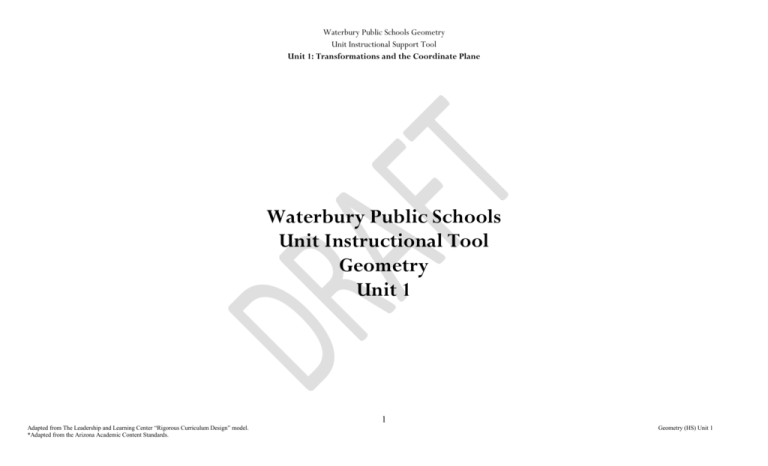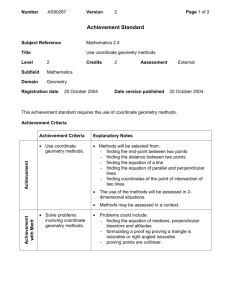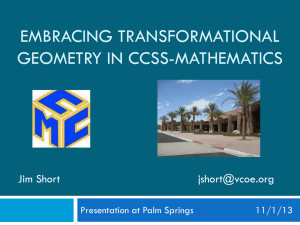Geometry Using Coordinates and Equations
advertisement

Waterbury Public Schools Geometry Unit Instructional Support Tool Unit 1: Transformations and the Coordinate Plane Waterbury Public Schools Unit Instructional Tool Geometry Unit 1 1 Adapted from The Leadership and Learning Center “Rigorous Curriculum Design” model. *Adapted from the Arizona Academic Content Standards. Geometry (HS) Unit 1 Waterbury Public Schools Geometry Unit Instructional Support Tool Unit 1: Transformations and the Coordinate Plane Pacing: 4 weeks + 1 week for re-teaching/enrichment = 20 days/periods + 5 days/periods re-teach/enrichment – 25 days/periods total Mathematical Practices Mathematical Practices #1 and #3 describe a classroom environment that encourages thinking mathematically and are critical for quality teaching and learning. Practices in bold are to be emphasized in the unit. 1. Make sense of problems and persevere in solving them. 2. Reason abstractly and quantitatively. 3. Construct viable arguments and critique the reasoning of others. 4. Model with mathematics. 5. Use appropriate tools strategically. 6. Attend to precision. 7. Look for and make use of structure. 8. Look for and express regularity in repeated reasoning. Standards Overview Experiment with transformations in the plane. Understand similarity in terms of similarity transformations. 2 Adapted from The Leadership and Learning Center “Rigorous Curriculum Design” model. *Adapted from the Arizona Academic Content Standards. Geometry (HS) Unit 1 Waterbury Public Schools Geometry Unit Instructional Support Tool Unit 1: Transformations and the Coordinate Plane Periods 3 Priority and Supporting CCSS CC.9-12.G.CO.1 Know precise definitions of angle, circle, perpendicular line, parallel line, and line segment, based on the undefined notions of point, line, distance along a line, and distance around a circular arc. Suggested Instructional Strategies Performance Objectives Identify vertex, sides, and interior of an angle. Identify the basic parts of a circle (center, radius, and diameter). Identify parallel vs. perpendicular lines. Compare and contrast lines, rays and segments. Identifying Similarities and Differences Note Taking Summarizing Cooperative Learning Nonlinguistic Representations Vocabulary Development Have students write their own understanding of a given term. Give students formal and informal definitions of each term and compare them. Develop precise definitions through use of examples and non-examples. Discuss the importance of having precise definitions. Identifying Similarities and Differences Note Taking Summarizing Cooperative Learning Nonlinguistic Representations Vocabulary Development Allow students to explore and make conjectures about relationships between lines and segments using a variety of methods. Discuss the role of algebra in providing a precise means of representing a visual image. 4 CC.9-12.G.GPE.5 Prove the slope criteria for parallel and perpendicular lines and use them to solve geometric problems (e.g., find the equation of a line parallel or perpendicular to a given line that passes through a given point). Construct parallel or perpendicular lines and calculate the slopes to compare relationships. Given the equations of two lines, determine if they are parallel, perpendicular or neither. Find the equation of a line parallel or perpendicular to a given line that passes through a given point. Pre-Requisite Knowledge Resources Parts of Lines Lines, Line Segments, and Rays Circumference and Arc Length Understanding the undefined terms point, line, and plane. Understand distance is a non-negative quantity. ML Common Core Companion ML Geometry Concept & Skills: 1.3, 1.5, 1.6, 11.1, 3.1 ML Geometry: Ti-Nspire: Points, Lines, and Planes Ti-84 What is a linear pair? Parallel Lines Lesson MARS Finding Equations for Parallel and Perpendicular Lines Ti-Nspire Classifying Quadrilaterals Graph parallel and perpendicular lines using transformations. Write the equation of a line through a specific point. Ti-84 Classifying Quadrilaterals 3 Adapted from The Leadership and Learning Center “Rigorous Curriculum Design” model. *Adapted from the Arizona Academic Content Standards. Geometry (HS) Unit 1 Waterbury Public Schools Geometry Unit Instructional Support Tool Unit 1: Transformations and the Coordinate Plane Periods 5 Priority and Supporting CCSS CC.9-12.G.CO.4 Develop definitions of rotations, reflections, and translations in terms of angles, circles, perpendicular lines, parallel lines, and line segments. Suggested Instructional Strategies Performance Objectives Develop a definition for a reflection using perpendicular lines. Develop a definition for a translation using parallel lines. Develop a definition for a rotation using angles and/or circles. Relate work on parallel lines to systems of equations having no solution or infinitely many solutions. Identifying Similarities and Differences Note Taking Summarizing Cooperative Learning Nonlinguistic Representations Vocabulary Development Draw rotations, reflections, and translations. Use geometry software to model rotations, reflections, and translations. Pre-Requisite Knowledge Resources Mirror Tool Reflection in a Line Chapter III Isometries in the Plane: Classification and Structure McDougall Littell 7-3 Rotations - nexuslearning.net ML Geometry Concept & Skills: 3.7, 5.7, 7.6, 11.8 Use inductive reasoning to make conjectures. Know definitions and properties of angles, circles, perpendicular lines, parallel lines, and line segments. NCTM Lesson: An Interactive Introduction to Transformational Geometry Geometry Transformations: Reflection & Translation Geometry Transformations: Rotation & Dilation Transformation Games: Translations, Rotations & Reflections Ti-Nspire Introduction to Transformations 4 Adapted from The Leadership and Learning Center “Rigorous Curriculum Design” model. *Adapted from the Arizona Academic Content Standards. Geometry (HS) Unit 1 Waterbury Public Schools Geometry Unit Instructional Support Tool Unit 1: Transformations and the Coordinate Plane Periods 2 Priority and Supporting CCSS CC.9-12.G.CO.2 Represent transformations in the plane using, e.g., transparencies and geometry software; describe transformations as functions that take points in the plane as inputs and give other points as outputs. Compare transformations that preserve distance and angle to those that do not (e.g., translation versus horizontal stretch). Suggested Instructional Strategies Performance Objectives Manipulate a given figure to represent the different transformations (rotation, reflection, translation) Represent a translation as a function in coordinate notation. Compare transformations that preserve distance and angle to those that do not. Identifying Similarities and Differences Note Taking Summarizing Cooperative Learning Nonlinguistic Representations Vocabulary Development Understand that a function has one output for every input whether the input is a number or a point in the plane. Use M.C. Escher pictures to compare and contrast rigid and non-rigid transformations. Pre-Requisite Knowledge Resources Ti-84 Properties of Reflections Connecting Translations, Reflection, and Rotations ML Geometry Concept & Skills: 3.7, 5.7, 7.6, 11.8 Identify different types of transformations. NCTM Lesson: An Interactive Introduction to Transformational Geometry Geometry Transformations: Reflection & Translation Geometry Transformations: Rotation & Dilation Transformation Games: Translations, Rotations & Reflections Function Notation for Geometric Transformations Non-Rigid Motions Ti-Nspire Exploring Transformations 5 Adapted from The Leadership and Learning Center “Rigorous Curriculum Design” model. *Adapted from the Arizona Academic Content Standards. Geometry (HS) Unit 1 Waterbury Public Schools Geometry Unit Instructional Support Tool Unit 1: Transformations and the Coordinate Plane Periods Priority and Supporting CCSS Suggested Instructional Strategies Performance Objectives Pre-Requisite Knowledge Resources Ti-84 Connecting Translations, Reflections, and Rotations Exploring Transformations 2 CC.9-12.G.CO.3 Given a rectangle, parallelogram, trapezoid, or regular polygon, describe the rotations and reflections that carry it onto itself. Given a figure identify the type(s) of symmetry the figure has. If it has line symmetry sketch the figure and the lines of symmetry. If it has rotational symmetry state the angle of rotation. Identifying Similarities and Differences Note Taking Summarizing Cooperative Learning Nonlinguistic Representations Vocabulary Development Provide sets of polygons for students to manipulate. Use mirrors or a reflective device to help students see lines of symmetry. Shape Tool ML Geometry Concept & Skills: 3.7, 5.7, 7.6, 11.8 Geometry Transformations: Reflection & Translation Geometry Transformations: Rotation & Dilation Understand lines of symmetry. Understand properties of rectangle, parallelogram, trapezoid, and regular polygons such as angle measures and side lengths. Transformation Games: Translations, Rotations & Reflections Ti-Nspire Transformational Puppet 3 CC.9-12.G.CO.5 Given a geometric figure and a rotation, reflection, or translation, draw the transformed figure using, e.g., graph paper, tracing paper, or geometry software. Specify a sequence of transformations that will carry a given figure onto another. Given a geometric figure, draw the new figure under the given transformation. Given a preimage and an image, specify the sequence of transformations that will map the preimage onto the image. Identifying Similarities and Differences Note Taking Summarizing Cooperative Learning Nonlinguistic Representations Vocabulary Development Ti-84 Transformational Puppet ML Geometry Concept & Skills: 3.7, 5.7, 7.6, 11.8 Geometry Transformations: Reflection & Translation Understand the significance of the order in mathematics. 6 Adapted from The Leadership and Learning Center “Rigorous Curriculum Design” model. *Adapted from the Arizona Academic Content Standards. Geometry (HS) Unit 1 Waterbury Public Schools Geometry Unit Instructional Support Tool Unit 1: Transformations and the Coordinate Plane Periods Priority and Supporting CCSS Suggested Instructional Strategies Performance Objectives Have students use a variety of tools to explore and perform simple, multistep, and composite rotations, reflections, and translations. Given a transformation, work backwards to discover the sequence that led to that transformation. Identifying Similarities and Differences Note Taking Summarizing Cooperative Learning Nonlinguistic Representations Vocabulary Development Explore properties of geometric figures plotted on a coordinate axes system using graphing technology and dynamic software. Generalize coordinates of geometric figures using variables for one or more of the vertices. Derive the equation for a line through two points using similar right triangles. 2 CC.9-12.G.GPE.4 Use coordinates to prove simple geometric theorems algebraically. For example, prove or disprove that a figure defined by four given points in the coordinate plane is a rectangle; prove or disprove that the point (1, √3) lies on the circle centered at the origin and containing the point (0, 2). Given three points in a coordinate plane, find a fourth point to make the figure a parallelogram and prove your results. Prove or disprove that a given point lies on a circle given the center and a point on the circle. Pre-Requisite Knowledge Resources Transformation Games: Translations, Rotations & Reflections Ti-Nspire Absolutely Silver Dollar City Christmas LearnZillion Lesson Geometry Using Coordinates and Equations: Lessons 8-1 & 8.6 Ti-84 Perimeters, Areas, and Slopes - Oh, My! Calculate slopes, including slopes of parallel and perpendicular lines. Understand the relationship between parallel and perpendicular lines. Calculate distances using the distance formula. Understand basic properties of geometric figures (e.g., midpoint, segment length, Pythagorean Theorem). Understand the basic properties of polygons. 7 Adapted from The Leadership and Learning Center “Rigorous Curriculum Design” model. *Adapted from the Arizona Academic Content Standards. Geometry (HS) Unit 1 Waterbury Public Schools Geometry Unit Instructional Support Tool Unit 1: Transformations and the Coordinate Plane Periods 2 Priority and Supporting CCSS CC.9-12.G.GPE.6 Find the point on a directed line segment between two given points that partitions the segment in a given ratio. Suggested Instructional Strategies Performance Objectives Given the endpoints of a segment, find a point on the segment that divides it into a given ratio. Given one endpoint of a segment and a point on the segment with a given ratio, find the other endpoint. Find the midpoint of a segment. 2 CC.9-12.G.GPE.7 Use coordinates to compute Use coordinates to compute perimeters of perimeters of polygons and areas of triangles and polygons and areas of triangles and rectangles, e.g., using the distance formula.* rectangles. Pre-Requisite Knowledge Resources Identifying Similarities and Differences Note Taking Summarizing Cooperative Learning Nonlinguistic Representations Vocabulary Development Apply the midpoint formula to find the coordinates of one end of a line segment given the coordinates of the midpoint and its other endpoint Apply the midpoint formula to find the coordinates of the midpoint of a line segment given the coordinates of the endpoints of the line segment Apply the midpoint formula to determine the midpoint of a segment. Lesson 8-3: Geometry Using Coordinates and Equations Partitioning a Segment ML Geometry Concept & Skills: 2.1, 4.6 Identifying Similarities and Differences Note Taking Summarizing Cooperative Learning Nonlinguistic Representations Vocabulary Development Graph polygons using coordinates. Determine side lengths and perimeters of polygons. Midpoint Formula Areas in Geometry ML Geometry Concept & Skills: 4.4, 8.3-8.6 Distance Formula Find perimeter and area of a variety of shapes, including irregular shapes. Use the distance formula. Ti-Nspire Exploring Midpoints Ti-84 Finding the Endpoint of a Segment Given One Endpoint and the Midpoint Determining Area ( Ti-Nspire) Determining Area ( TI-84) 8 Adapted from The Leadership and Learning Center “Rigorous Curriculum Design” model. *Adapted from the Arizona Academic Content Standards. Geometry (HS) Unit 1 Waterbury Public Schools Geometry Unit Instructional Support Tool Unit 1: Transformations and the Coordinate Plane Periods Priority and Supporting CCSS Suggested Instructional Strategies Performance Objectives Resources Pre-Requisite Knowledge Calculate areas of triangles and rectangles. Given a triangle, use slopes to verify that the length and height are perpendicular. Find the area. Explore perimeter and area of a variety of polygons, including convex, concave, and irregularly shaped polygons. 9 Adapted from The Leadership and Learning Center “Rigorous Curriculum Design” model. *Adapted from the Arizona Academic Content Standards. Geometry (HS) Unit 1 Waterbury Public Schools Geometry Unit Instructional Support Tool Unit 1: Transformations and the Coordinate Plane Concepts What Students Need to Know o perpendicular line ● precise definitions o parallel line o angle o line segment o circle ● definitions o rotations o reflections o translations ● definition of similarity ● meaning of similarity ● similarity transformations Skills What Students Need To Be Able To Do ● KNOW Bloom’s Taxonomy Levels 1 ● DEVELOP 3 ● USE 3 2 3 ● EXPLAIN ● USE ● slope criteria for o parallel lines o perpendicular lines ● geometric problems ● PROVE and USE 5 and 3 3 ● SOLVE 10 Adapted from The Leadership and Learning Center “Rigorous Curriculum Design” model. *Adapted from the Arizona Academic Content Standards. Geometry (HS) Unit 1 Waterbury Public Schools Geometry Unit Instructional Support Tool Unit 1: Transformations and the Coordinate Plane Essential Questions In what ways can polygons be moved so that the properties of the polygons are preserved? How can Algebra be useful when expressing geometric properties? Corresponding Big Ideas The properties of the polygon are preserved only if the polygon is transformed through one or a series of rigid motions. Algebra can be used to efficiently and effectively describe, apply and prove geometric properties. 11 Adapted from The Leadership and Learning Center “Rigorous Curriculum Design” model. *Adapted from the Arizona Academic Content Standards. Geometry (HS) Unit 1






